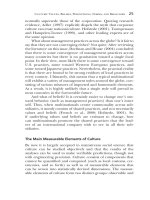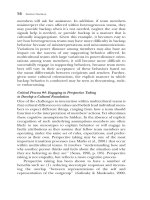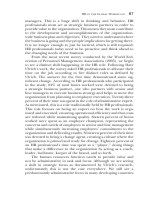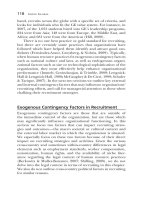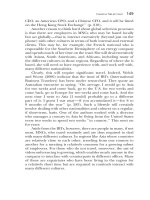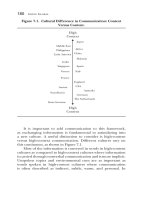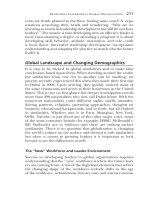Solutions manual for accounting and financial analysis in the hospitality industry 1st edition by hales van hoof
Bạn đang xem bản rút gọn của tài liệu. Xem và tải ngay bản đầy đủ của tài liệu tại đây (753.91 KB, 23 trang )
Solutions Manual for Accounting and Financial Analysis in the Hospitality Industry
1st Edition by Johnathan Hales and Hubert B. Van Hoof
Jonathan Hales
Northern Arizona Universit
Prentice Hall
Boston Columbus Indianapolis New York San Francisco Upper Saddle River
Amsterdam Cape Town Dubai London Madrid Milan Munich Paris Montreal Toronto
Delhi Mexico City Sao Paulo Sydney Hong Kong Seoul Singapore Taipei Tokyo
Copyright © 2011 Pearson Education, Inc., publishing as Prentice Hall, Upper Saddle River, New Jersey and
Columbus, Ohio. All rights reserved. Manufactured in the United States of America. This publication is protected
by Copyright, and permission should be obtained from the publisher prior to any prohibited reproduction, storage in
a retrieval system, or transmission in any form or by any means, electronic, mechanical, photocopying, recording, or
likewise. To obtain permission(s) to use material from this work, please submit a written request to Pearson
Education, Inc., Permissions Department, One Lake Street, Upper Saddle River, New Jersey.
Many of the designations by manufacturers and seller to distinguish their products are claimed as trademarks.
Where those designations appear in this book, and the publisher was aware of a trademark claim, the
designations have been printed in initial caps or all caps.
10 9 8 7 6 5 4 3 2 1
ISBN-13: 978-0-13-507276-9
ISBN-10:
0-13-507276-X
TABLE OF CONTENTS
INTRODUCTION
ABOUT THE AUTHOR
TEACHING ACCOUNTING TO HOSPITALITY
STUDENTS
INSTRUCTORS MANUAL
CHAPTER OUTLINES
ANSWERS TO REVIEW QUESTIONS
ANSWERS TO PRACTICE EXERCISES
ANSWERS TO PICTURE DISCUSSION POINTS
APPENDICES
SAMPLE SYLLABUS
SAMPLE PROJECTS
SAMPLE EXAMINATIONS (TB)
INTRODUCTION
The purpose of this accounting textbook is to teach accounting to hospitality
students in a way that they will understand accounting and be able to use it in their
hospitality careers. Traditional accounting courses assume students want to learn the
details and complexities of accounting rules and regulations, how to prepare accounting
reports and financial statements, and that students understand the accounting language.
They teach accounting courses as if all of their students are accounting majors and will
take numerous accounting courses.
Nothing can be further from the truth. Hospitality students want to be hospitality
managers with careers in rooms, food and beverage, sales, human resources as well as
most other areas of hospitality operations….except accounting! Hospitality students
often just hope to survive their accounting classes and hope that minimal damage will be
done to their GPA’s. Typically they have not done well in introductory accounting
classes, often have difficulty understanding and working with numbers especially in an
accounting context, generally fear the class or have high anxieties about the class, and in
general, have a negative approach or perspective in taking accounting classes.
This accounting textbook approaches accounting in a fundamental way emphasizing
what hospitality students have already learned about math and numbers and how basic
applying accounting to hospitality operations can be. The only math required is addition,
subtraction, multiplication and division. Emphasizing positive aspects of accounting
including its value in their career advancement, emphasizing understanding and
analyzing accounting statement rather than preparing them, and using real hospitality
industry examples can go a long way in building both student confidence and interest.
Therefore this accounting textbook focuses on the fundamentals of accounting and
financial analysis and how hospitality students use numbers contained in management
reports and financial statements in operating their departments. The book is written in
English and not accounting. It focuses on using not preparing financial reports. It covers
how accounting is used in the daily operations of hotels and restaurants. Directors of
Finance from Four Seasons, Hyatt and Marriott have graciously reviewed the material in
this textbook to ensure that it is current and correctly presents how accounting is used
and applied in actual hospitality operations.
There are several key points and concepts that are used throughout the book and
form the framework for the material presented. They are:
1. There are two main uses of accounting and financial reports in hospitality
operations. They are to measure financial performance and to be used as a
management tool.
2. The three key measurements of the success of any business are employee
satisfaction, customer satisfaction, and financial profitability and cash flow.
1
This book focuses on the financial aspect of these measurements but it is important to
understand that all three of these work together. A problem with one will lead to a
problem in all three. That is why it is important to understand accounting.
3. It is important to understand how accounting and finance fit into business
operations. The Financial Management Cycle explains this:
A. Operations produce the numbers
B. Accounting prepares the numbers
C. Both operations and accounting analyze the numbers
D. Operations apply the numbers back to operations to grow and improve
4. The Career Success Model shows the important knowledge and skills that any
successful manager will need to posses to advance to greater responsibilities and
senior management. Accounting courses offer the knowledge to understand and
apply numbers to operations.
HIGH PERFORMANCE
ORGANICATIONS
MARKETING KNOWLEDGE
ACCOUNTING AND FINANCE KNOWLEDGE
MANAGEMENT AND LEADERSHIP SKILLS
TECHNICAL SKILLS
5. It’s the P&L Baby!!! Any manager in business will be required to work with
P&L Statements…in general terms with a Summary or Consolidated P&L and in
very specific terms with their Department P&L. It is essential that hospitality
managers understand and are comfortable working with numbers and the
financial statements that will help them run their departments. The Balance Sheet
and Statement of Cash Flows are important but are primarily taken care of by
the Accounting Department.
6. Accounting Concepts and Methods of Financial Analysis are the terms that
describe the important information to know and understand. The accounting
concepts will form the foundation of how numbers are organized and used in
management reports and financial statements - an accounting process. Financial
analysis is how analysis and application are applied to accounting reports and
financial statements to give them meaning - a management process.
7. This book tries to provide the most current and specific accounting information
available, without compromising confidential and proprietary information. Therefore
actual reports used in major hospitality companies are presented in this textbook.
This should be very helpful to hospitality students to see actual rather than
theoretical accounting examples courtesy of Four Seasons, Hyatt, Host Marriott,
Marriott International, and Omni hotel companies as well as Red
Lobster Restaurants.
2
ABOUT THE AUTHOR
Jonathan A. Hales has been associated with the hospitality industry since 1972
with 23 years working in the industry for Marriott International and 15 years teaching in
the School of Hotel and Restaurant Management at Northern Arizona University. In an
effort to keep current with the hospitality industry growth and development, he has
completed many faculty internships with companies in the hospitality industry including:
Summer 2005 Marriott International
Summer 2003 Hyatt Hotels
Summer 2003 Red Lobster Restaurants
Summer 2002 Four Seasons Hotels
Summer 2001 Omni Hotels
Professor Hales began his hospitality career in 1972 as an Assistant Controller
Trainee for Marriott International at the Twin Bridges Marriott in Washington D.C.
After completing his accounting training, he went on to be Assistant Controller at the
1,000 room New Orleans Marriott, the 350 room Camelback Inn in Scottsdale,
Arizona, and at the 800 room Philadelphia Marriott. New Orleans and Philadelphia
were large convention hotels while Camelback Inn is a resort.
His first Controller position was at the 428 room St. Louis Airport Marriott. In
August of 1978, he was promoted to the opening Controller of Marriott’s Rancho Las
Palmas Resort in Palm Springs, California. This 340 room resort was the first resort
built by Marriott and included management of Rancho Las Palmas Country Club and its
27 hole golf course, 25 tennis courts, and the Clubs food and beverage operations for
860 condominium owners.
After completing Marriott’s Executive Training Program, Professor Hales was
assigned as Resident Manager for the 400 room Houston Greenspoint Marriott in 1983
and moved up to be the Resident Manager of the 778 room Miami Airport Marriott in
1985. Resident Manager responsibilities included Front Office, Housekeeping, Gift
Shop, Security and in Miami, the Tennis Club operations.
In 1989 he was named General Manager of the 310 room Tampa Westshore Marriott
and returned in 1990 as General Manager of Miami Airport Marriott. During his tenure
as General Manager, Professor Hales was on the board of the Hillsborough County
Hotel and Motel Association, a member of the Greater Miami Hotel and Motel
Association, Chairman of the Marriott Business Council of Miami in 1994, winner of
the first annual Alice S. Marriott Community Service Award in 1992 at Miami Airport,
and recipient of the Chairman’s Award of Excellence for his leadership of the Miami
Airport Marriott after Hurricane Andrew in August 1992. In the summer of 1995, the
Miami Airport Marriott converted 284 rooms into a Fairfield Inn and 128 rooms into a
Courtyard becoming one of the first multi-brand Marriott Properties.
3
In the summer of 1995, Professor Hales relocated to Northern Arizona University in
Flagstaff, Arizona as a Marriott Executive on Loan. After 25 years with Marriott, he
retired in 1997 to become a faculty member of the School of Hotel and Restaurant
Management at Northern Arizona University.
Professor Hales has been the Intern Coordinator and Director of Native
American Programs for the School of Hotel and Restaurant Management. Currently
he is an Associate Professor teaching Hospitality Accounting, Hospitality Corporate
Finance, Resort Management and Senior Seminar.
He received his BA in Economics and a Certificate in International Relations from the
University of Utah, an MBA from Arizona State University, a Masters in Education
Leadership at Northern Arizona University, and a Doctorate in Education Leadership at
Northern Arizona University. He studied one year in the MBA program at the Darden
School of Management at the University of Virginia. After receiving his MBA, Professor
Hales spent two years as a Financial Analyst for Motorola Semiconductor Products
Division in Phoenix, Arizona and Austin, Texas before returning to Marriott as Assistant
Controller in Philadelphia in 1975.
4
TEACHING EFFECTIVE ACCOUNTING
FOR HOSPITALITY MAJORS
Jonathan A. Hales, MBA, EdD
INTRODUCTION AND PREVIOUS LITERATURE
Most hospitality programs in the United States include several accounting and
finance courses in their curriculum. While these accounting classes are important and
provide knowledge and skills that every hospitality manager will need, students are
generally afraid of, have high anxiety levels, do not like, and do not do well in these
classes. Often the result is that they just try and survive the class and do not try to
understand and learn the accounting and finance concepts presented in the class that will
help them in their hospitality careers.
Understanding fundamental accounting concepts and methods of financial
analysis are important skills for graduating students to possess as they begin their
hospitality careers. They should posses a solid foundation of accounting knowledge and
concepts as well as fundamentals of financial analysis that will enable them to quickly
learn, understand, and apply the accounting policies and procedures of the hospitality
company that they work for. It will often mean the difference between steady career
advancement and no advancement at all. The following information discusses the
problems and challenges of organizing and structuring accounting classes to be more
effective and offers a process that will overcome these problems and result in a more
effective class structure and learning environment.
WHY CURRENT ACCOUNTING CLASSES
ARE NOT AS EFFECTIVE AS THEY NEED TO BE
There are several reasons why traditional hospitality accounting courses are not as
effective as they could be in teaching college students the important concepts and principles
of accounting and finance that they will need to know and use in their careers.
1. Traditional accounting classes and textbooks teach to potential accountants,
not potential hospitality managers. The textbooks not only present the basics,
but also go into great detail about accounting theory and preparing endless
spreadsheets that are important for accountants but not useful for hospitality
majors. This ends up confusing and frustrating students and being one more thing
that they don’t understand. The application of accounting concepts to daily
hospitality operations is far more beneficial to hospitality majors.
2. The accounting material presented is too complicated and often confusing
because it includes too much detail about accounting procedures and
5
information that is only used by accountants. Problems and case studies get
more complex and deal with unusual (but possible) accounting situations. Most
of these are far beyond the understanding of hospitality managers and these
examples and situations presented will never be used by them in the daily
operations of their departments. Problems and case studies should present current
material, examples and situations that managers will encounter in daily business
operations such as food and wage cost critiques and forecasting and budgeting.
Repetition of these kinds of problems will be a great benefit to hospitality
managers because they will be encountering these problems in daily operations.
Managers will be expected to identify and understand problems and to be able to
effectively deal with them.
3. Typical accounting textbooks are too long, too expensive and too theoretical.
They are usually over 500 pages and often the extensive material will confuse
students and result in “information overload” and frustrated students. The real
problem is that the accounting material presented in the first part of these
chapters is important and could form a solid understanding of accounting
concepts and operations. Unfortunately, the chapters then go on and on with more
details and complexity that often go beyond what the student needs to understand.
Students often get confused and the good done in the first part of the chapter is
undone or negated by the complicated and theoretical material presented at the
end of the chapter.
4. Hospitality students are afraid of accounting classes, don’t like them, are
intimidated by them and don’t do well in them. “Taking a final exam in a
math or accounting ranked highest on the anxiety scale. Studying for a math or
accounting test ranked second.” Ward and March, p.61 (2002). Student’s
approach is to stay awake, survive, and not do too much damage to their GPA. If
the organization of the accounting material is fundamental and applicable to
their jobs as a hospitality manager, students will then be more open, positive and
involved in the class.
THE FOCUS FOR AN EFFECTIVE
ACCOUNTING CLASS
It is important to remember that accounting classes are a part of the core curriculum
for hospitality managers. These students will graduate with a degree in Hospitality or
Hotel and Restaurant Management, not with a degree in Accounting. Therefore, the
accounting classes should be viewed as a core course leading to a Hospitality degree, not
a core course leading to an Accounting degree. Students need to have a fundamental
understanding of using numbers in operating their departments and analyzing their
financial statements. An accounting class should present and focus on the following
important goals:
6
1. The class should provide students a solid foundation of fundamental
accounting concepts and methods of financial analysis.
2. Students should understand numbers and be able to use numbers in helping them
perform their managerial job responsibilities more effectively.
3. Students should understand that using financial analysis in evaluating business
operations involves basic arithmetic and fundamental formulas and need not be
complicated and overwhelming.
4. Students should understand that numbers resulting from operations are used as a
management tool and a means to evaluate financial performance. This includes
an understanding of other financial measurement in addition to profits. “Students
must be brought to an understanding of the larger picture – the value of the
enterprise, measured in cash flows, against the value of firms in the same sector,
as well as in comparison to alternative investments.” Beals, p. 76 (2001).
5. Students should be able to apply these concepts and methods in managing their
operations, reviewing financial performance and evaluating financial statements.
A TEACHING PLAN
FOR HOSPITALITY ACCOUNTING AND FINANCE
A successful curriculum for a hospitality accounting class should include several changes
from traditional approaches. These are basic yet very important changes. They are 1) to teach
a smaller amount of accounting topics, 2) to teach them thoroughly and clearly, 3) to
demonstrate the application of these concepts to current business operations,
4) to establish a solid foundation of accounting and finance knowledge. The accounting
and financial material presented should be the concepts students must know and be
able to use to be a successful hospitality manager. Following are six elements that
could be beneficial in designing the course material:
1. Eliminate the fear of accounting and working with numbers.
2. Focus on the fundamentals emphasizing arithmetic and basic formulas.
3. Emphasis that accounting concepts and methods of financial analysis go
hand in hand.
4. The Financial Management Cycle
5. The Career Success Model
6. The Importance of having a complete understanding of the Profit and
Loss Statement (P&L).
7. The importance of understanding other key financial measurements such
as cash flow, return on equity, and economic value.
1. Eliminate the fear of accounting and working with numbers! This is so important in
creating a positive and open mind set for the students. The instructor should give student’s
constant encouragement that they will be able to learn and use accounting information.
“Students have confirmed the impact that teachers have on quantitative performance.” Ward
and March, p.63. Examples and problems that focus on the basics of
7
accounting will also build student confidence. The class can then progress to more
detail or complexity once the basic understanding is in place.
2. Focus on the fundamentals emphasizing arithmetic and basic formulas. The
sooner students understand and use basic arithmetic in analyzing business operations, the
sooner they will be comfortable and confident in learning fundamental accounting
concepts. After all, average room rates are calculated by dividing room revenue by
rooms sold. Occupancy percent is calculated by dividing rooms sold by total rooms.
Food cost and wage cost percentages are calculated by dividing food expenses by food
sales and wage expenses by food sales. Basic arithmetic! REVPAR, probably the most
important statistic in maximizing room revenues is calculated by multiplying average
room rate by occupancy percentage. Again, basic arithmetic!
3. Accounting concepts and methods of financial analysis go hand in hand. This
means that an understanding of fundamental accounting concepts is necessary to be able
to use and understand methods of financial analysis. Hospitality managers need to
understand accounting to be able to use and apply the information in operating their
business. The first step is understanding accounting concepts and the second step is
applying methods of financial analysis in evaluating current business operations.
4. The Financial Management Cycle. It is important to understand this concept that
demonstrates how numbers and accounting are generated and used in business
operations. This concept deals with the flow and use of numbers in business operations.
First, Operations produce the numbers. All the activities involved in the daily
operations of a business produce the numbers that measure performance. In a hotel,
the daily operations provide products and services to guests including the rooms
department, food and beverage outlets, gift shop and other departments that involve a
sales transaction with the guest. Numbers used in financial analysis have to come
from somewhere and that is the daily operations of the business.
Second, Accounting prepares the numbers and provides financial reports
and statements. At the end of the day, week, or month, all operations and activities
are collected, summarized and reported in financial reports prepared by the
accounting department. These reports describe the business operations and activities
and are distributed to the appropriate managers for their review and use.
Third, Accounting and Operations analyze the numbers. Operations
management and accounting management work together to review and analyze the
reports. They look for changes, the cause of the change, and the result of the change to
understand operations and determine ways to correct and improve them. Together they
have operational and financial analysis experience and can identify the changes or
improvements that need to be made to ensure that productive operations continue.
Fourth, Operations applies the numbers back to the business. After reviews
and discussions, it is the operations managers that make any necessary changes to
8
operations to correct or improve them. The ability to analyze quickly and accurately
and then to make any necessary changes is an important part of any business
operation. It enables the business to constantly improve by being more productive,
creating more value in the products and services that they provide, or identifying new
processes and procedures.
5. The Career Success Model
There are certain skills and abilities that are required for any manager to have that
result in a successful business career. Stephen R. Covey talks about three of these in his
book The Seven Habits of Highly Effective People, (1989) Covey defines skill as “how
to do”, knowledge as “what to do” and attitude as “want to do.” p. 47 The use of these
three abilities determines how successful a manager can be.
The Career Success Model (Exhibit 1) identifies four individual skills and one
organizational skill that are very helpful in enabling managers to successfully manage
departments or businesses and advance with a company. It is very important that
managers continue to grow and to learn, and this includes expanding their knowledge
to new and challenging areas that will broaden their skills and abilities.
Technical Skills
These are the day to day operational skills and knowledge required to get a specific
job done and to operate a specific department. Entry level managers in the hospitality
industry will start out as Assistant Desk Managers, Assistant Housekeeping Managers,
Assistant Restaurant Managers and so forth. The job description defines what they are
expected to know and to be able to do to accomplish all the required tasks and
responsibilities necessary in operating their department. New managers spend the first
year learning and doing. That should be their focus – to learn all the aspects of their job.
This includes knowing and being able to perform the jobs of all the employees that report
to them. For example, Assistant Desk Managers will be checking guests in and out,
managing room inventories, handling group business, staffing the concierge level,
running fronts for the bellman etc. Assistant Restaurant Managers will be seating
customers, bussing tables, and expediting food orders. Understanding these technical
aspects of daily operations is essential to the department’s success and to establishing a
solid foundation for personal career growth for the manager.
Management/Leadership Skills
The first promotion provides a manager with more opportunities to manage others in
getting the job done. The additional knowledge and skills needed include working with
other managers as well as hourly employees. This step involves the progression
9
from managing – we manage things, to leading – we lead people Covey, (1989). A
manager is now paid to get other people to do the job. This includes the typical
management responsibilities of planning and control but has now progressed to the
leadership responsibilities of motivating, challenging, engaging, supporting and
recognizing employees. The real definition of a leader is the ability to teach and inspire
the people they work with that will result in higher job performance and higher job
satisfaction.
Leaders also have the responsibility to allocate company resources. This includes
allocating time, money, labor and ideas to the most productive or profitable projects and
departments. They do this by listening to employees and customers and then prioritizing
projects or job responsibilities, and then supporting them with sufficient resources.
What does this have to do with accounting and finance? Everything! Specifically, the
more knowledgeable and comfortable that a manager is in working with numbers and
completing the accounting and financial analysis part of their job, the more time they will
have to spend with their customers and employees – their top priorities!
Unfortunately, the careers of many managers slow down or stop at this point. They do
not have the interest, knowledge, or ability to learn the next skills that will help them to
do a better and more complete job, and to advance taking on more and wider areas of
responsibility. It is just not enough to have management/leadership and technical skills to
advance to higher positions within a company. These positions require the knowledge
and ability to understand accounting and marketing concepts in the daily operations of
their company.
Financial Skills
Financial knowledge and skills begin with 1) understanding numbers, 2) having the
ability to communicate or teach what the numbers mean, and 3) having the ability to
apply what is learned from numbers to improve the operations of the business.
Specifically, it is the ability to interpret and discuss the information contained in
financial reports with all levels of management. A manager must be as comfortable
talking about the financial aspects of their department as the operational aspects of their
department with the hotel controller, general manager, or regional managers. Explaining
revenues, profits, and expenses, comparing actual results to budgets and forecasts, and
making recommendations and adjustments to improve operations are all important
financial skills for any manager to possess.
It is important to understand that every hospitality manager must have a fundamental
understanding of accounting and finance to grow and advance within a company. They
do not have to be Certified Public Accountants or Directors of Finance. But they must
be able to intelligently discuss both the operational and financial performance of their
departments with them and senior management. This should be the primary objective of
a Hospitality Accounting class at the college level – teach hospitality students to
understand, analyze and communicate financial performance.
10
Marketing Skills
The next step in the Career Success Model is developing Sales and Marketing
knowledge and skills which begin by identifying and understanding customers and their
expectations. What does a hotel or restaurant do to develop and maintain a competitive
advantage over its competitors? Why does a customer choose to stay in a particular hotel
or eat in a particular restaurant? The Marketing Department is responsible for identifying
customer preferences, expectations, buying patterns, and behavior patterns. This
customer information is then classified into different market segments. A hotel or
restaurant identifies which market segments that it wants to and can successfully
compete in by meeting customer expectations.
Each of these market segments are defined by specific customer expectations and
behavior patterns. For a manager to continue to advance, they must understand the
marketing of their hotel or restaurant. What are the strengths and competitive advantages
of a property? What are the expectations and preferences of your customers? A manager
must be able to discuss their customers with the Director of Sales or Marketing and
understand the marketing plan and positioning of their hotel or restaurant.
When a manager is knowledgeable and comfortable with these four
individual skills, they have the potential to be a part of a “high
performance organization.” A manager with strong individual skills
and knowledge, and with a positive attitude can then create or be a part
of an organization that not only meets but exceeds the expectations and
goals it has established.
HIGH PERFORMANCE ORGANIZATIONS
It is the ultimate goal of any hotel or restaurant or department within a hotel or
restaurant, to achieve outstanding financial results and performance. This requires a
team effort by all involved in the operation. The greater the degree of knowledge and
skill in these four areas, the greater the contribution a manager can make to the
performance of his team or department. Only when a manager can translate excellence
of individual performance into excellence of team performance, can they truly excel and
achieve outstanding performance.
11
The Career Success Model outlines the knowledge, skills and abilities that are
required to be successful in business and to advance to senior management positions.
The goal of a Hospitality Accounting class should be to provide students with the
accounting and financial knowledge, skills and abilities necessary to be successful in the
careers that they choose.
12
6. The importance of having a complete understanding of the Profit and Loss
Statement (P&L). Of the three main financial statements – Profit and Loss Statement,
Balance Sheet, and Statement of Cash Flows – the P&L Statement is the one that
hospitality managers will be required to work with in operating their departments. Their
daily activities and decisions in operating their departments will impact the results
contained in their Department P&L. Therefore, they must have a solid understanding of the
relationship of department operations to Profit and Loss Statements.
Following is a list of knowledge and skills that a hospitality manager will be
expected to understand and use in their hospitality career.
1. A thorough knowledge of Department and Consolidated P&L Statements
A. the information required to prepare a P&L Statement
B. the P&L format that presents the financial information
C. the ability to analyze and critique a P&L Statement
D. the ability to understand productivities and profit margins
2. A working knowledge of financial and productivity management reports
A. Daily Revenue Report
B. Labor scheduling and productivity reports
3. A working knowledge of forecasting
A. Weekly and monthly revenue forecasts
B. Weekly wage schedules
4. Purchasing, inventories, and accruals
The P&L Statement is the main financial report that hospitality managers will be
expected to use and understand in the daily operations of their departments. The actions
that they take, the tools that they use and the decisions that they make will all show up
at the end of the month in the financial results contained in their Department P&L
Statement. These will also be recorded on the Consolidated P&L. Managers need to
understand how their daily actions and decisions impact both P&L Statements and be
able to analyze and critique them to explain how the numbers were produced and what
they mean.
It might be useful at this time to review the four steps in the Financial Management
Cycle and understand that the daily operations of a department or business produce the
numbers reported in financial documents. This is the first step in the Financial
Management Cycle. Managers must then be able to understand and analyze these
numbers, the third step, and to make any necessary changes or improvements to their
operations, the fourth step.
The Balance Sheet and Statement of Cash Flows are also important financial reports to
understand when evaluating the operational and financial performance of a business.
However, these reports are mainly used by the accounting managers in the performance
13
of their job responsibilities. Accountants are expected to understand and analyze what
these reports mean and make the necessary changes or improvements. Rarely does an
operations manager get involved with the analysis of these reports.
8. The importance of understanding other key financial measurements such as cash
flow, return on equity and economic value. These accounting concepts are also very
important in successfully operating and analyzing business operations. A positive cash
flow and liquidity are essential to maintain daily operations. A business is expected to
generate sufficient operating revenues to pay operating expenses. “The truly
conscientious instructor should begin the process of orienting the student to the financial
realities of the hospitality industry from the very first financial accounting course. Teach
not only the operating cycle and the elegance of the matching principle, but also the
cash-to-cash cycle. Introduce capital flows and differentiate them from operating flows
from the beginning, instead of leaving them for the end of the course.”
Beals, p.76. These additional financial concepts should be a natural extension of
understanding P&L Statements. Because they are an important financial component of
evaluating business operations, they should be included in a hospitality accounting class.
Understanding the basic accounting concepts of return on owner equity and return on
investment are essential if students are to learn and be able to use accounting concepts
and measurements that are actually used in the hospitality industry. Teaching should go
beyond the mere calculating of ratios to understanding the business and financial
concept behind them and why they are so important in understanding and evaluating
business operations.
SUMMARY
Traditional hospitality accounting classes generally do not connect with hospitality
students. This is because the focus of the course is on presenting accounting information for
accountants not hospitality students. This is a major problem because hospitality students
need to know, understand and be able to use accounting information and financial analysis
in performing their jobs and operating their departments. Hospitality Accounting course
content should therefore focus on the important fundamental accounting concepts and not
focus on complicated accounting procedures used by accountants. Those details and
procedures are rarely used by hospitality managers in department operations. This
information more often confuses or discourages or students.
Part of the process of designing a balanced accounting course is to build confidence
in the students in their ability to be able to understand and use accounting as a hospitality
manager. The first step is to realize that most of the accounting that they will be using
involves fundamental arithmetic and not complicated formulas, college algebra, or
complex accounting. To create a strong foundation of accounting knowledge, the focus
should be on accounting fundamentals and how they are applied to successfully and
profitably operating a hospitality operation.
14
Some or all of the following concepts can help to make a hospitality accounting
class more effective and understandable for the students. 1) Eliminate student’s fear of
accounting and working with numbers, 2) Focus on accounting fundamentals
emphasizing arithmetic and key formulas, 3) Understand that accounting concepts and
methods of financial analysis go hand in hand, 4) Introduce the Financial Management
Cycle, 5) Explain the Career Success Model, 6) Spend the most time on the P&L
Statement, the financial report that they need to know and understand as hospitality
managers, 7) Present and discuss other key financial measurements of business
operations such as cash flow, return on equity, and economic value.
There are three reasons to focus on accounting fundamentals. First, this will create a
strong accounting foundation for the student and enable them to learn and to grow into
more detailed or complicated accounting and financial analysis. Second, students will
not be able to understand and use the more detailed and complicated accounting if they
do not understand the fundamentals. Third, confidence is an important ingredient in
learning, and by starting off with the key fundamentals, the student can build the
confidence necessary to expand their accounting knowledge and progress to other useful
methods of financial analysis that will enable them to be more effective and successful
as a hospitality manager.
15
ACCOUNTING AND FINANCIAL ANALYSIS
IN THE HOSPITALITY INDUSTRY
INSTRUCTORS MANUAL
CHAPTER 1
INTRODUCTION TO NUMBERS, ACCOUNTING
AND FINANCIAL ANALYSIS
Chapter Outline
Introduction
Numbers – the lifeblood of business
Definitions and Formulas
Customers, Associates, and Profitability
Career Success Model
Technical Skills
Management/Leadership Skills
Financial Skills
Marketing Skills
High Performance Organizations
Financial Statements
The Profit & Loss Statement
The Balance Sheet
The Statement of Cash Flows
The Statement of Stockholders Equity
Revenues – The Beginning of Financial Performance
Formulas
Market Segments
The Customer
Profit – The Ultimate Measure of Financial Performance
Department Profit
House Profit
Net House Profit
Profit before and after taxes
Summary
Hospitality Manager Take-Aways
Key Terms
Formulas
Review Questions
Practice Exercises
16
Answers to Review Questions
1. Name and describe the three main financial statement of a business. Include
the characteristics of each financial statement.
The Profit & Loss Statement, The Balance Sheet, and the Statement of Cash Flows.
P&L Characteristics
1. It covers a specific time period, for example month, accounting period, year.
2. It reports the actual financial results for a business for the specific time period.
3. It compares the actual financial performance to other measures such as budget,
the previous year, the previous month or previous accounting period.
4. It includes a Summary or Consolidated P&L statement and supporting
Department P&L statements
5. A new P&L statement is started each month or accounting period and records
information for the current month/accounting period and year to date (YTD).
6. Managers are expected to analyze or critique their monthly P&L Statements
to explain variations – both positive and negative - from the budget or from
the previous year.
Balance Sheet Characteristics
1. It measures the value or net worth of a company at a specific point in time.
2. The fundamental accounting equation describes the Balance Sheet
3. It is made up of accounts organized by assets, liabilities, and owner equity.
4. These accounts are divided into current accounts under one year and long term
accounts over one year.
5. Each account has a beginning balance, monthly activity, and an ending
balance. The ending balance for one month becomes the beginning balance for
the next month.
6. Operations managers are not expected to provide monthly Balance Sheet critiques.
7. Accounting managers balance monthly the accounts on the Balance Sheet
Statement of Cash Flows Characteristics
1. It involves the cash account of the Balance Sheet
2. It has beginning and ending balances.
3. It shows how money is used in the daily operations of the business.
4. It measures liquidity.
5. It is a fundamental component of working capital.
6. It reflects the increases and decreases in Balance Sheet accounts.
7. There are three classifications of Cash Flow:
Operating activities
Financial activities
Investment activities.
17
2. Define REVPAR and explain why it is so important as a revenue measurement
for room revenues as well as total hotel financial performance.
REVPAR is an important measure of a hotel’s ability to generate room revenue by
measuring average rate and occupancy percentage in maximizing total room revenue. It
is calculated in two ways, Total Room Revenue divided by Total Rooms, or Average
Room Rate times Room Occupancy Percentage. REVPAR shows how well the hotel
management is managing both average room rates and total rooms sold. It is important
because room departments in a hotel have the highest department profit margins, are
generally the largest revenue departments, and maximizing total room revenue will
often have the greatest impact on maximizing total hotel profits.
3. Name and describe the four profit levels in a hotel.
Department Profit measures the profit generated by each individual
revenue/profit department in the hotel.
Total Department Profits measure the total profitability of all the revenue/profit
departments in the hotel.
House Profit/Gross Operating Profit measures the hotel profit remaining after the
cost of expense centers have been deducted from Total Department Profits. It measures
management’s ability to manage all the hotel resources to maximize House Profit.
Net House Profit/Adjusted Gross Operating Profit measures the total hotels financial
performance after fixed expenses are deducted from House Profit.
*Profit After Taxes measures the remaining profit after all expenses and taxes have
been paid. It is often distributed between the owners, management companies, franchise
companies, or any other organizations that have a financial interest in the hotel.
4. What is the difference between capitalization and working capital? What is each
used for in business operations?
Capitalization involves the start up, expansion or renovation of a business and generally
involves the long term assets, long term liabilities and owner equity accounts.
Working Capital involves the day-to-day operations of a company and generally
involves the short term asset and short term liability accounts. It includes revenues
and the managing of daily cash flows in the business.
5. Why is understanding accounting concepts and methods of financial
analysis important to a hospitality manager?
Accounting Concepts form the foundation for working with numbers in measuring
financial performance. They are rules, policies and procedures that ensure that the
numbers are prepared and presented accurately for anyone that reads or uses
financial reports.
Methods of Financial Analysis are ways to use the financial numbers produced by
operations to evaluate the success or lack of success of the business. It involves analyzing
and comparing numbers to guidelines such as the budget or last years actual
18
performance. Financial analysis brings the numbers to life in describing the results
of business operations.
6. What are the three key measurements of the performance of a business?
Associates - Customers - Financial Performance (profitability and cash flow).
7. Why is the P&L Statement the most important financial statement for a hospitality
manager to understand?
The P&L Statement is the most important financial statement for operations managers to
know and understand because these managers work with and can affect revenues and
they can control and manage most costs associated with operations. Their daily
activities in operating the business produce the numbers reported on the P&L. They
need to understand how the numbers resulted, how to analyze the numbers, and how to
make improvement to operations as a result of what the numbers tell them about hotel
operations.
8. What are the formulas for?
Room revenue
Occupancy %
RevPAR
Profits
Retention/Flow through
Room rate x rooms sold
Rooms sold / total rooms
Room Revenue / total rooms
Revenues - expenses
Change in profit $ / change in revenue $
Practice Exercises
1. Match the following types of accounts to their balance sheet classification:
_B_Accounts Payable
_A_ Cash
_C_ Equipment
_A_ Inventory
_D_ Bank Loan
_A_ Accounts Receivable
_E_ Retained Earnings
_B_ Taxes Payable
_E_ Initial Capital Accounts
_E_ Common Stock
A. Current Asset
B. Current Liability
C. Long-Term Asset
D. Long-Term Liability
E. Owner Equity
19
2. Match these equations
_B_ Revenues - Expenses
_A_ Current Assets – Current Liabilities
_F_ Revenues - Cost of Sales, Wages, Benefits,
and Operating Expenses
_D_ Wage Cost / Revenues
_G_ Profit Dollars / Revenue Dollars
_C_ Room Revenues / Total Rooms
_E_ Change in Profit Dollars / Change in Revenue Dollars
3. Match the financial statement with the description
_B_ Has opening and ending balances
_B_ Is the same as an A&L Statement
_A Closes out accounts at the end of an accounting cycle
_C_ Is the same as a Source and Use of FundsStatement
_A_ Is the same as an Income Statement
_B Shows the value or net worth of a company
_A_ Measures the operating success of a company
_C_ Shows the liquidity of a company
A. Working Capital
B. Profit Formula
C. RevPAR
D. Cost Percent
E. Retention/Flow-through
F. Department Profit
G. Profit percent
A. P&L
B. Balance Sheet
C. Statement of Cash Flows
Answers to chapter questions on the J.W. Marriott Desert Ridge
1. Group is the largest market segment because of the size of the resort, the large
amount of meeting space, and all the different food and beverage and
recreational opportunities.
2. The rooms department generates the most revenues because of the large number of
rooms and the high average room rate. The banquet department also generates
significant revenues because of the large amount of indoor and outdoor meeting
space. The restaurant operations in a resort can also generate high revenues because
of the many specialty restaurants typical of resorts. For example a steak house,
Chinese restaurant, Italian restaurant, golf club restaurant, pool bar, etc.
3. The departments with the highest profits will generally be:
First – Rooms because of high profit margins and average room rates
Second – Banquets because of large amount of meeting space, high average
checks, and other revenue generators such as meeting rooms and
A/V Third – Beverage because of low cost of sales and low labor costs
Fourth – Spa and Golf because of relatively high treatment revenues and
greens fees
Fifth – Restaurants are generally the lowest because of high food and labor costs
20



